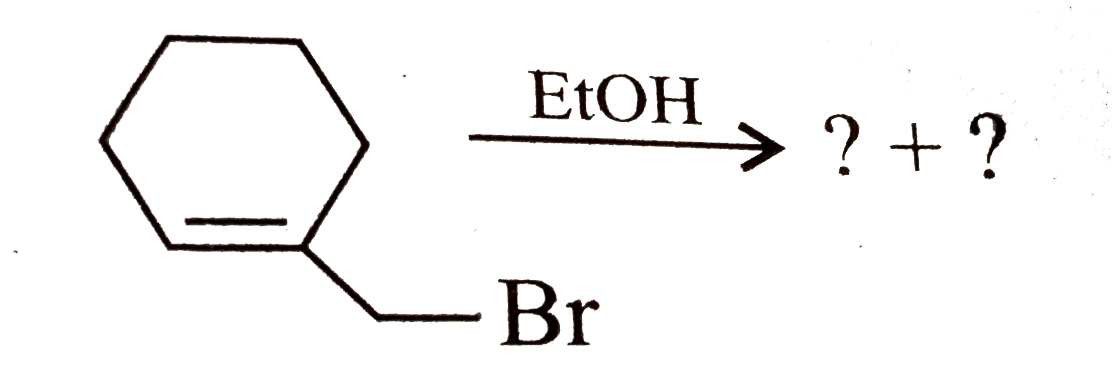In which of the following reactions, SN2 rate increases on changing the solvent from (95 % acetone + 5 % H2O) to (80 % acetone + 20 % H2O) ?
Me2−⊕P−Me+NH3→Me⊕NH3+Me2P
MeI+PH3→Me⊕PH3+IӨ
MeBr+ӨOH→MeOH+BrӨ
Me2−⊕S−Me+ӨOH→MeOH+Me2S
The correct Answer is:B
To determine in which of the following reactions the SN2 rate increases when changing the solvent from 95% acetone + 5% water to 80% acetone + 20% water, we need to analyze the effect of solvent polarity on the SN2 reaction mechanism.
1. Understanding SN2 Mechanism:
- The SN2 (Substitution Nucleophilic Bimolecular) reaction involves a nucleophile attacking an electrophile, leading to the substitution of one group for another. The rate of an SN2 reaction depends on both the nucleophile and the substrate.
2. Effect of Solvent on SN2 Reactions:
- The solvent can affect the rate of the reaction by stabilizing or destabilizing the reactants and transition states.
- In a polar solvent, charged species (like nucleophiles or electrophiles) are stabilized due to solvation, which can slow down the reaction if the reactants are charged.
3. Changing Solvent Composition:
- By changing the solvent from 95% acetone (a polar aprotic solvent) + 5% water to 80% acetone + 20% water, we are increasing the polarity of the solvent mixture.
- Increasing the proportion of water (which is a polar protic solvent) increases the overall polarity of the solvent.
4. Analyzing Reactants:
- If the reactants are charged (e.g., a nucleophile like OH⁻), increasing solvent polarity will stabilize the charged reactants, thus decreasing the reaction rate.
- If the reactants are neutral, increasing the solvent polarity will stabilize the transition state, which can increase the reaction rate.
5. Conclusion:
- Based on the above analysis, the SN2 reaction rate will increase when the reactants are neutral and the solvent polarity is increased.
- Therefore, we need to identify the reaction among the options provided where the reactants are neutral.
Final Answer:
The correct answer is B, where the SN2 reaction rate increases upon changing the solvent from 95% acetone + 5% water to 80% acetone + 20% water.
- The SN2 (Substitution Nucleophilic Bimolecular) reaction involves a nucleophile attacking an electrophile, leading to the substitution of one group for another. The rate of an SN2 reaction depends on both the nucleophile and the substrate.
- The solvent can affect the rate of the reaction by stabilizing or destabilizing the reactants and transition states.
- In a polar solvent, charged species (like nucleophiles or electrophiles) are stabilized due to solvation, which can slow down the reaction if the reactants are charged.
- By changing the solvent from 95% acetone (a polar aprotic solvent) + 5% water to 80% acetone + 20% water, we are increasing the polarity of the solvent mixture.
- Increasing the proportion of water (which is a polar protic solvent) increases the overall polarity of the solvent.
- If the reactants are charged (e.g., a nucleophile like OH⁻), increasing solvent polarity will stabilize the charged reactants, thus decreasing the reaction rate.
- If the reactants are neutral, increasing the solvent polarity will stabilize the transition state, which can increase the reaction rate.
- Based on the above analysis, the SN2 reaction rate will increase when the reactants are neutral and the solvent polarity is increased.
- Therefore, we need to identify the reaction among the options provided where the reactants are neutral.
The correct answer is B, where the SN2 reaction rate increases upon changing the solvent from 95% acetone + 5% water to 80% acetone + 20% water.
Topper's Solved these Questions
- ORGANIC REACTION MECHANISMBOOK - CENGAGE CHEMISTRY ENGLISHCHAPTER - ORGANIC REACTION MECHANISMEXERCISE - Assertion-Reasoning
12 Videos
- ORGANIC REACTION MECHANISMBOOK - CENGAGE CHEMISTRY ENGLISHCHAPTER - ORGANIC REACTION MECHANISMEXERCISE - Archives
8 Videos
- ORGANIC REACTION MECHANISMBOOK - CENGAGE CHEMISTRY ENGLISHCHAPTER - ORGANIC REACTION MECHANISMEXERCISE - Multiple Correct
30 Videos
- NCERT BASED EXERCISEBOOK - CENGAGE CHEMISTRY ENGLISHCHAPTER - NCERT BASED EXERCISEEXERCISE - Chemical Equilibrium
73 Videos
- P-BLOCK GROUP 13 - BORON FAMILYBOOK - CENGAGE CHEMISTRY ENGLISHCHAPTER - P-BLOCK GROUP 13 - BORON FAMILYEXERCISE - Exercise Archives (Subjecive)
9 Videos
Similar Questions
Knowledge Check
For the following reaction, select the statement that best describes the change.
RCH2OH+PCC[C5H5NH+ClCrO−3]→AThe alcohol is oxidized to an acid, and the Cr(VI) is reducedBThe alcohol is oxidized to an aldehyde, and the Cr(VI) is reducedCThe alcohol is reduced to an aldehyde, and the CrCIII) is oxidizedDThe alcohol is oxidized to a ketone, and the Cr(VI) is reduced
Greenhouse gas CO2 can be converted to CO(g) by the following reaction
CO2(g)+H2(g)→CO2+H2O(g) , termed as water gas reaction.
A mixture of gases containing 35 vol% of H2,45 vol.% of CO and 20 vol. % H2O is heated to 1000K . What is the composition of the mixture at equilibrium?
View SolutionWhat is the percentage strength of a solution of 100 volume H2O2?
View SolutionWhat is the percentage strength of a solution of 100 volume H2O2?
View SolutionGive all the possible major and minor products (SN1andE1) in the following. Explain.

(b) If t-pentyl shloride reacts with 25%H2O and 75%C2H5OH in NaOH, what are the possible products formed ? Explain with mechanism.
View SolutionAn organic compound contains C,H and O. If C(%):H%=6:1, what is the simplest formula of the compound, given that one mole of the compound contains half as much oxygen as would be required to burn all the C and H atoms in it to CO2 and H2O?
View SolutionThe mole fraction of water in 20%(wt./wt.) aqueous solution of H2O2 is:
View SolutionPredict the effect of increasing the percentage of H2O in acetone −H2O solvent mixture in :
(a) SN1 solvolysis of Me3C−Br
(b) SN2 reaction of K1 and EtC1.
(c) Predict the relative yields of the product of Me3CBr in 80%EtOH and 20%H2O.
View Solution
